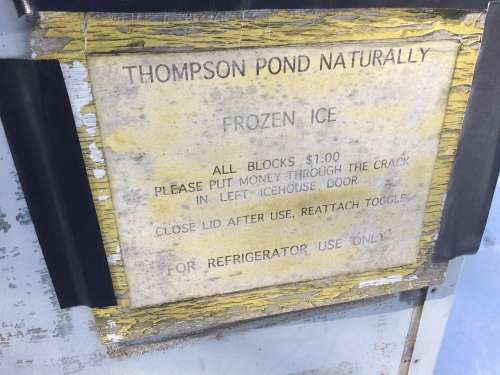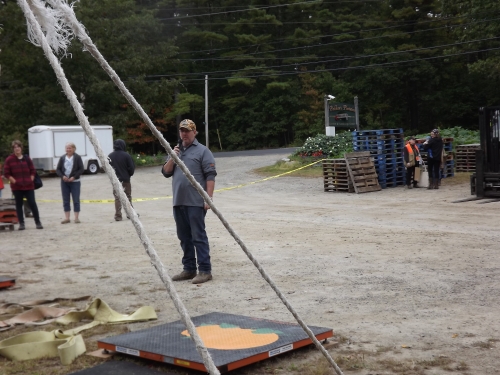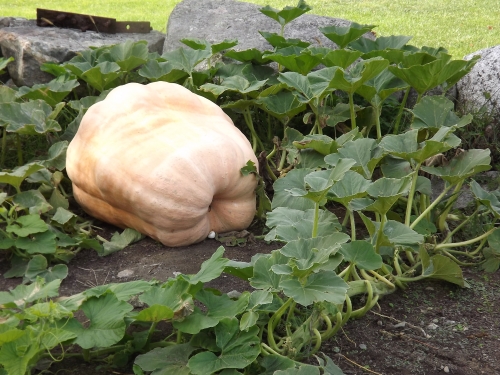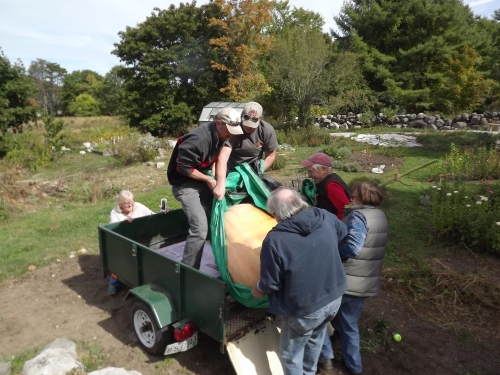Husband and I celebrated our 30th anniversary by spending 30 hours on the island of Vinalhaven. That might seem a poor return, one hour for each year, but one reason we’ve been together for 30 years is our shared enthusiasm for modest moments and for adventure. Vinalhaven was as charming as any modest adventurer could want. All good.
We sailed out of Rockland on a sturdy ferry, and after an hour and 15 minutes, arrived in Vinalhaven. The two towns were explained thoroughly by their harbors. Rockland was filled with elegant sailboats and yachts:

Vinalhaven’s harbor was filled with lobster boats. We had arrived at a place where hard work is done:


Vinalhaven is home to artist Robert Indiana (of “LOVE” logo fame), and one (count it) AirBnB rental where we spent the night. There were three very nice restaurants in the town, and because it was post-Labor Day (by 1 day), every single one of them was closed. Yes, I had made a reservation at one, but it was cancelled at the last minute due to the chef becoming ill, and our only option (as our rental did not have a kitchen) was to go to the local bar. As our host put it, “You’ll get some local color!” No kidding. Not the much-anticipated elegant dinner out I was dreaming of, but again, we’d made it 30 years by rolling with all of the dips and dives Life throws at us, so it seemed appropriate to start the next 30 by rolling once again.
You’ll see from the text in ”Appreciating” that the population of Vinalhaven island is small. The town itself is even smaller, and there are so many ways to define “small town” when talking about a place to live and work. The dictionary says the term “small town” can mean “of or concerning the regions outside the capital city of a country, especially when regarded as unsophisticated or narrow-minded.”
I accept that definition, but I don’t like it much. Thornton Wilder’s small town was a place where people showed every side of their humanity, and everyone was the better for it. I like that better. It also seems to apply to Vinalhaven, based on my vast experience of 30 hours.
I loved the beauty of the island, taking two lovely hikes to see water, woods, and birds, and I loved the Humanity of the small town as demonstrated by posted signs and by items in the local newspaper. I will share these with you, as I believe they will best explain why we enjoyed our 30 hours there so very much, and why we plan to go back – this time with a car! If we’d honeymooned there, I wouldn’t have blinked at carrying a backpack for two days, but remember, my back is now 30 years older, and I have learned to appreciate the value of a car seat and a pack-free back.
Here we go. First up, SIGNS.





There were lovely scenes to photograph on the island and I took several. Husband, who was taking photos for future paintings, took over 450. (One reason our budget and consequently our marriage has lasted 30 years is the invention of the digital camera.)



And now for copy from “The Wind”, the local paper that is published weekly. It offers a glimpse into Island life – the lingo, the cherished events, the hazards, and the ridiculous moments that a close community shares.
First, Vinalhaven residents are not immune to the hazards posed by careless drivers. Here is an apology, and a plea that made me sad:
“LAWN SALES: Sorry for canceling earlier lawn sales. I was rear-ended on the Philbrook as I exited my truck, hurting my back and smashing my bumper a couple of weeks ago.”
“Please tell me who hit my white Cadillac on the 18th, 1st boat leaving Rockland. A black SUV was seen on camera. It’s my only car for the rest of my life. Please call…”
Insider Tip: On Vinalhaven, the flea market is called “the Flea.” And apparently you have to go there yourself to see who is selling. Great marketing ploy! “Who’s selling? You have to find out for yourself!”:
“FLEA MARKET: Some of us will be at the Flea this Saturday…”
No community is immune from “That Guy.” The guy that takes advantage, acts badly, and explains it away with a smile:
“OBSERVER: A wonderful pair of long time seasonal residents graciously hosts a little gathering for friends each Labor Day as an expression of their appreciation for this place….One thing or another interfered with my being able to arrive in time to enjoy the happy hour but I did pull in just in time to hear the invitation to lunch and so —I’m aggressive when I’m hungry – headed directly to the buffet, first in line in front of others who had waited patiently for the invitation to partake. Having settled in with a plate piled high, I was prepared to enjoy it and the company of others for a while but then my watch alarm went off reminding me that I was to meet the ferry in ten minutes and so I wolfed down lunch and bolted. I do want to be invited back next year and so this note of explanation and appreciation.”
Vinalhaven is populated by humans, who as a species are known to make threats, including those that could be described as holding a gun to your head:
“7 Guns in 7 Days” Raffle to benefit the Vinalhaven Veterans Memorial Fund: Unless we sell 300 tickets by September 15th, we will be forced to end this raffle…”
This one is both thoughtful and ridiculous:
“!!! A PRODUCT RECALL !!! : Because of a proofing error, 2017 ICMS calendars are being replaced and reissued. (Days and dates for June, 2017 are out of sync, and we can’t have brides and grooms showing up on the wrong day).”
When you do business on a small island, every customer counts. Hence this Above-and-Beyond offer from a popular restaurant to provide passage across a natural barrier:
“NEBO LODGE: Need a ride from VH? We can help. Call us for dinner reservations and we will gladly arrange a round-trip ride across the Thoroughfare for you.”
A perfect pun for a community surrounded by salt water:
“BENEFIT DANCE…Featuring the “Six Foot Swells”
A candid moment from one innkeeper, and an incident worthy of a movie. Also, I love the idea that the local nuisance wildlife includes minks. You can’t make this stuff up:
“THE OBSERVER: …As many have pointed out, I am not quite as focused as I once was. Thus it was that a recent prospective guest received a confusing and somewhat troubling e mail confirmation and called for an explanation. It seems my note to the cleaning crew, asking that they clean up a distressing mess lift by a mink that had snuck in to a room through an open deck door, instead became an e mail confirming a reservation for later in the summer. The e mail read “We look forward to seeing you…Please clean up the little pile of waste just inside the deck door before you do anything else.”
Vinalhaven folks are honest:
“Mooring Money: Someone has a ‘rental’ mooring abreast the Evelyn J. It’s been used for a couple of days but there is no indication of where rental $ should be left or sent so we collected what we thought was fair and have it at the Tidewater.”
And, hands down, this is my favorite entry. This was a long list of thank-yous to the locals for helping out at a wedding, but I’ve included my two “bests”. I love a place so small and modest that only two music stands made a genuine difference, and….who is this OTHER guy?!
“The Evans family at Roberts Harbor wish to thank all who helped make the wedding of Jane…and Adam…a special day…The Union Church which loaned two music stands. To the bearded man who guided out-of-towners to the wedding at Charlotte’s field…”
Vinalhaven: The island were people work, pitch-in, offer, and ask. The island populated by fishermen, musicians, and mysterious bearded men. The island where minks leave messes, and local color is a good thing.
We’re going back.
WORDS FROM OTHERS:
“Lake Wobegon, the little town that time forgot and the decades cannot improve.”
— Garrison Keillor, American author, storyteller, humorist (1942- )
APPRECIATING
“Vinalhaven Island lies twelve miles off the coast of Maine, and is the state’s largest off-shore community. It is known for its striking natural beauty and for being home to one of the world’s largest lobster fishing fleets. We have a year-round population of about 1200 people, and welcome many more from around the world in the summer months…. Lobster fishing and related support activities make up roughly half of the island’s economy; in addition to commercial fishermen and women, we are builders, musicians, plumbers, teachers, shopkeepers, electricians, innkeepers, artists, writers, mechanics, realtors, restauranteurs, boat builders, ferry captains, architects, administrators, conservationists, and more.
— http://www.vinalhaven.org












































































































